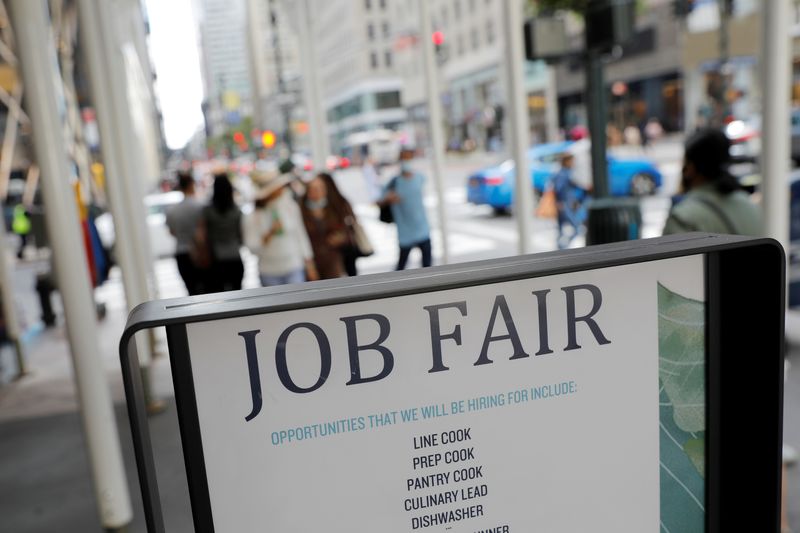By Lucia Mutikani
WASHINGTON (Reuters) - U.S. producer prices increased moderately in March as a rise in the cost of services was softened by a fall in goods prices, calming fears of a resurgence in inflation.
The report from the Labor Department on Thursday led economists to anticipate milder increases in the inflation measures tracked by the Federal Reserve for monetary policy relative to the strong consumer price readings in March.
High inflation and persistent labor market strength have prompted financial markets and most economists to push back expectations for an initial Fed interest rate cut to September from June. The minutes of the U.S. central bank's March 19-20 policy meeting, which were released on Wednesday, also showed policymakers were concerned that progress on inflation might have stalled.
"Producer prices tell us that inflation is not worsening, yet," said Christopher Rupkey, chief economist at FWDBONDS. "Policymakers can remain vigilant as they await more data on where inflation is heading next. Tamer producer prices may spell some relief for consumers in coming months."
The producer price index for final demand rose 0.2% last month after increasing by an unrevised 0.6% in February, the Labor Department's Bureau of Labor Statistics said. Economists polled by Reuters had forecast the PPI would gain 0.3%.
In the 12 months through March, the PPI advanced 2.1% after rising 1.6% in February.
Consumer prices increased more than expected in March for the third straight month, government data showed on Wednesday. Since March of 2022, the Fed has raised its benchmark overnight interest rate by 525 basis points to the current 5.25%-5.50% range, where it has been since last July.
The cost of services increased 0.3% in March after rising by the same margin in February, the PPI report showed. That was driven by a 3.1% surge in the cost of securities brokerage, dealing, investment advice and related services. Portfolio management fees gained 0.5%.
There were also increases in the prices of professional and commercial equipment wholesaling, investment banking as well as computer hardware, software and supplies retailing. Airline fares rose 2.2% after climbing 2.7% in February.
But the cost of hotel and motel rooms fell 3.8%. Health and medical insurance rose 0.2%.
GOODS PRICES FALL
Portfolio management fees, healthcare, hotel and motel accommodation, and airline fares are among the components that go into the calculation of the personal consumption expenditures (PCE) price index, which the Fed uses to track it 2% inflation target.
Goods prices slipped 0.1% after jumping 1.2% in February. The decline reflected a 3.6% drop in wholesale gasoline prices. There were also decreases in the prices of eggs, carbon steel scrap, jet fuel, fresh fruit and melons.
But prices for processed poultry jumped 10.7%, likely reflecting shortages triggered by outbreaks of bird flu. Prices for fresh and dry vegetables, residential electric power and motor vehicles also increased. Excluding food and energy, goods prices edged up 0.1% after advancing 0.3% in February.
Based on the PPI and CPI data, economists estimated a moderate pace of increase in the core PCE price index, with unrounded estimates ranging from 0.21% to 0.28%. Core inflation rose 0.3% in February. The annual increase in core inflation is estimated to have slowed to 2.7%, which would be the smallest gain in three years, from 2.8% in February.
Overall PCE inflation was forecast to have climbed 0.28%, which would lift the year-on-year increase to 2.6%. PCE inflation rose 0.3% in February and advanced 2.5% on a year-on-year basis.
"Although the pace of disinflation has slowed, fears of a resurgence in inflation look overdone," said Paul Ashworth, chief North America economist at Capital Economics.
Stocks on Wall Street were trading higher. The dollar rose marginally against a basket of currencies. U.S. Treasury prices were mixed, with the yield on the two-year note hitting 5% for the first time since November.
Despite the promising producer price data, the last mile in the road to low inflation will likely remain tough amid a persistently tight labor market.
In a separate report on Thursday, the Labor Department said initial claims for state unemployment benefits dropped 11,000 to a seasonally adjusted 211,000 for the week ended April 6. Economists had forecast 215,000 claims for the latest week.
Unadjusted claims increased 17,037 to 214,386 last week. There was a surge of 4,190 in filings in New Jersey, likely the result of temporary layoffs related to spring breaks at public schools. There were also notable increases in claims in New York, Texas, Oregon and Pennsylvania.
The Easter and Passover holidays, whose timing shifts every year, also tend to inject volatility into the claims data. Nonetheless, last week's data suggested the labor market remained healthy early in the second quarter. Job growth accelerated in March, while the unemployment rate slipped to 3.8% from 3.9% in February.

The number of people receiving benefits after an initial week of aid, a proxy for hiring, increased 28,000 to 1.817 million during the week ending March 30, the highest level since January, the claims report showed. The uninsured unemployment rate was unchanged at 1.2%.
"Even though hiring is slowing, net payroll growth remains strong thanks to the low level of layoffs in the economy, and there is no sign from the claims data that the story is changing," said Michael Pearce, deputy chief U.S. economist at Oxford Economics.
